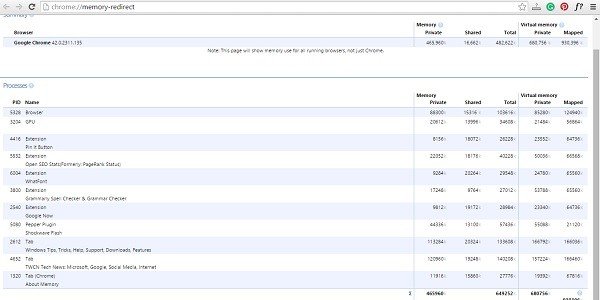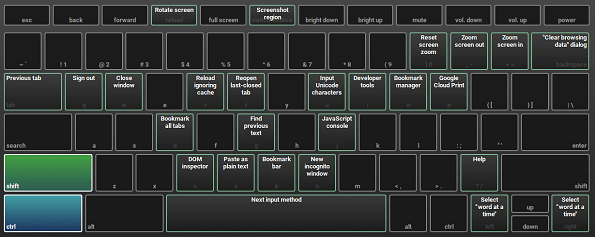

- #Google chrome task manager shortcut windows how to
- #Google chrome task manager shortcut windows password
- #Google chrome task manager shortcut windows plus
- #Google chrome task manager shortcut windows windows 7
- #Google chrome task manager shortcut windows windows
When Chrome offers to save a password when you log in to a site, there’s no keyboard method to say yes or no - you have to click on one of the buttons that appear. (All keyboard shortcut commands should have toolbar icons or menu entries as equivalents, and those icons or commands should always list the keyboard shortcut as a visual reminder.) At least one keyboard command, Ctrl+O to open a file, has no listing anywhere on any menu. Ctrl+S does nothing instead of saving the current web page, although you can right-click (even with Shift+F10) and choose “Save as” from the shortcut menu. The list of keyboard shortcuts in their help is very incomplete. #Google chrome task manager shortcut windows windows
In a very serious breach of Windows usability, the F1 key does nothing at all instead of calling up help. There’s no apparent way to open the “Control the current page” and “Customize and control Google Chrome” dropdown menu icons in the upper right, except by clicking. Alt+Enter after typing a URL in the omnibar still opens a new tab with that content.Īll in all, I’m pretty pleased with the keyboard control of Chrome, but there’s a lot of room for improvement in this beta:. (You cannot choose a specific search engine with Alt+Down Arrow as you can with Firefox.) Ctrl+K or Ctrl+E to search does still work too, but not quite in the same method as Firefox: It simply moves you up to the omnibox with a question mark pretyped, which will then allow you to type in your search term and press Enter to get a search result. You set font size the same way: Ctrl+= (aka Ctrl++) still makes the font bigger, Ctrl+- (dash) makes the font smaller, and Ctrl+0 resets it back to normal. Ctrl+B toggles on/off the bookmark bar. For navigation, Alt+Home goes to the home page and you can use Alt+Left Arrow and Alt+Right Arrow (or Backspace and Shift+Backspace) to go back or forward a page in your history. :max_bytes(150000):strip_icc()/002_google-chrome-task-manager-4103619-5be23c70c9e77c0026de8f47.jpg)
Ctrl+L still jumps you up to the location bar (called an “omnibox” in Google Chrome parlance).
For tab navigation, you’ll use Ctrl+T to create a new tab, Ctrl+1 or Ctrl+2 (etc.) to switch tabs (or Ctrl+Page Up/Ctrl+Page Down), Ctrl+W to close a tab, and Ctrl+Shift+T to re-open a tab you just closed. There are a few exceptions, which I’ve outlined below. The majority of the Firefox keyboard shortcuts we’ve covered here previously do work in Chrome. 

#Google chrome task manager shortcut windows plus
This is Google’s browser, currently only for Windows, and its arrival rekindles the browser wars into a three-way race between Mozilla’s Firefox, Microsoft’s Internet Explorer, and now Google’s Chrome.Ĭhrome offers much faster loading speed and more stability as its main differentiators, but also a new feature called an “incognito session” (which we’ll cover later today), plus the ability to quickly use web sites (such as Gmail) as applications on your desktop and Start menu. You can also press Shift + Esc on your keyboard to open the task manager as well.Google Chrome was released in beta today (Tuesday, September 2). Step 2: Right-click in an empty space at the top of the window, then click the Task Manager option. Step 1: Launch the Google Chrome Web browser, or open the Chrome window if the browser is already running. You can also use another tool in the task manager to get some more detailed stats about all of your resource usage as well. In an effort to help you control these elements, Google offers a task manager, where you can see and end any running process that you wish. Running processes, add-ons and toolbars are three of the factors that will reduce the performance of Google Chrome. Launching the Task Manager in Google Chrome
#Google chrome task manager shortcut windows how to
How to change the startup page in Google Chrome.How to start Google Chrome automatically.
#Google chrome task manager shortcut windows windows 7
Set Google Chrome as default browser in Windows 7. How to see recent downloads in Google Chrome. How to turn off hardware acceleration in Google Chrome. If you want to know how to open the Google Chrome task manager, you can continue reading this tutorial to see the exact method that is required to do so, as well as a handy keyboard shortcut that can expedite the process even further. However, you might not be aware that Google Chrome has its’ own dedicated task manager that will tell you all of the processes and add-ons that are running along with the browser and your tabs. If you have ever pressed Ctrl + Alt + Delete to open the Task Manager in Windows, then you probably have an idea of what I am referring to. A lot of the time, when you have a Web browser open, there are more processes and applications running than you think.



:max_bytes(150000):strip_icc()/002_google-chrome-task-manager-4103619-5be23c70c9e77c0026de8f47.jpg)




 0 kommentar(er)
0 kommentar(er)
